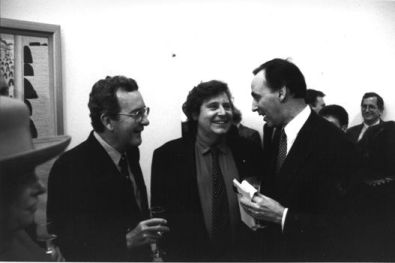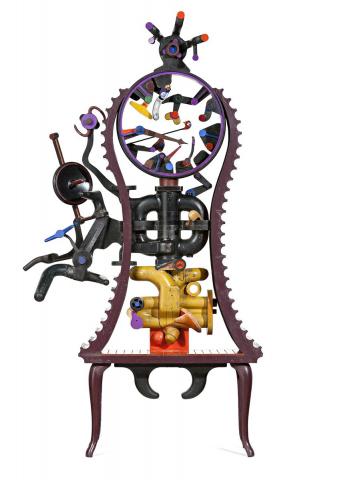ATLAS, 1965
COLIN LANCELEY
oil on carved wood and metal
241.0 cm height
Gallery A, Sydney
The Estate of the late James O. Fairfax AC, New South Wales, acquired from the above in 1965
Colin Lanceley ’65, Gallery A, Sydney, 18 March – 20 April 1965 (illus. in exhibition catalogue)
Colin Lanceley – A Survey Exhibition 1961 – 1987, Art Gallery of New South Wales, Sydney, 24 July – 15 September 1987
Gleeson, J., ‘The Art Collectors 3. James O. Fairfax’, Art and Australia, Ure Smith, Sydney, vol. 3, no. 3, December 1965, pp. 174, 177 (illus.)
Colin Lanceley, Relief tondos & ‘Wasteland’ drawings, Whitechapel Art Gallery, London, 9 September – 19 October 1975 (illus. in exhibition catalogue)
Wright, W., and Hughes, R., Colin Lanceley, Craftsman House, Sydney, 1987, fig. 9, pp. 110 (illus.), 131
Fairfax, J., My Regards to Broadway. A Memoir, Angus and Robertson, Sydney, 1991, p. 314
Wright, W., and Hughes, R., Colin Lanceley, Craftsman House, Sydney, revised edition, 1993, fig. 9, pp. 134, 156
As a student at the East Sydney Technical College in 1959 – 60, Colin Lanceley and his friends would play a game called Aesthetic Chess, making ephemeral table-top compositions using bus tickets, coins, lipstick, cigarettes and whatever they had in their pockets. With two of these friends, Mike Brown and New Zealand-born Ross Crothall, Lanceley formed the Annandale Imitation Realists in the early 1960s and together they produced a provocative body of assemblages that drew on sources as diverse as the irrational spirit of Dada, contemporary popular culture, kitsch and their fascination with tribal art, that astounded and confounded audiences when they were exhibited in 1962.
44 - JAMES FAIRFAX, COLIN LANCELEY AND PAUL KEATING.jpg

JAMES FAIRFAX, COLIN LANCELEY AND PAUL KEATING
Working independently by 1963, Lanceley recalled that ‘collage was becoming more and more important to me. It became more than just a working process – it became a philosophy of life … and it seemed to me that the kinds of things I was interested in picking up, the objects and the bits and scraps and flotsam and jetsam, all had clinging to them a poignant history that evoked a whole other existence … bringing life into art’.1 A significant moment in the development of his practice occurred in 1963 when, scouring the streets of Balmain for materials with his friend, the sculptor Robert Klippel, they discovered a cache of wooden patterns that had been used for sand-casting maritime machine parts in the abandoned basement of an engineering workshop. 2 Wonderfully coloured and to the untrained eye, presenting a series of varied sculptural forms in their own right rather than being functional objects with a distinct use, these patterns became the basis of new work by both artists, who ‘ransacked the store, carrying off patterns by the vanload’. 3
Lanceley used the wooden patterns, adding other found elements and sometimes painted colour, to produce a series of ambitious freestanding works that combined collage and sculpture on a large scale, and it was with some of these dynamic and utterly original works that he won the prestigious Helena Rubinstein Travelling Scholarship in 1964. Before leaving for Europe the following year he showed a group of these sculptures in a solo exhibition at Gallery A in Sydney. Atlas, 1965 was included in the exhibition and like other works from the period such as Icarus, 1965 (National Gallery of Australia) and Phoenix Among the Stars, 1965 (Private collection, Melbourne), took its title from Greek mythology, making reference to the Titan, Atlas, who, as a punishment from Zeus was forced to hold up the heavens for eternity. Perhaps alluding to the never-ending nature of his fate, Atlas is reminiscent of a clock, its face composed of a series of coloured dials and hands that have gone slightly awry, and the inner mechanics exposed within an elegantly curved body. Standing on the carved legs of a chair or small side table, Atlas is also a whimsical study of contrasts – solidity and air, order and chaos, the unfamiliar rendered familiar – that speaks to the pleasure Lanceley took in these materials and his joy of making.
1. Lanceley, C., quoted in Hughes, R. and Wright, W., Colin Lanceley, Craftsman House, Sydney, 1987, p. 22
2. Hughes, R., ‘Introduction’, ibid., pp. 11 – 12
3. ibid., p. 12
KIRSTY GRANT
Former Director of Heide Museum of Modern Art
Former Senior Curator, National Gallery of Victoria
